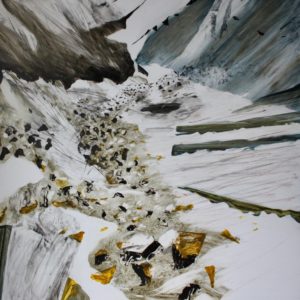
I am now prepared, about to set off on a walk, the route has been planned, the rucksack packed, water, food and map are priorities, lunch spots suggested and alternative routes and watercourses noted; just in case any encounters with Pyrenean Mountain Dog or the temperature gets too hot for the dogs or we just feel like changing the route or shortening the walk for some reason. The first steps are made following a track whilst making the additional minor adjustment to the rucksack or clothing.
The American artists James Turrell has been exploring space and perception through the untouchable phenomena of light and someone whose work has had a lasting impression since first experiencing his exhibition 'Air Mass' at the Hayward Gallery, London 1993. Turrell’s medium is pure light. He says, “My work has no object, no image and no focus. With no object, no image and no focus, what are you looking at? ”
http://jamesturrell.com/about/introduction/ (accessed 19/11/18)
For me, seeing this work for the first time was a real physical and emotional encounter, disorientating my own perceptions and sense of space.
The ability to be able to reach out and extend a limb or move the body into a space as a means of understanding is innate within us, and therefore the perception of space is only an illusion until we change our position and move through that space and time. Have you ever reached out to do a simple task, such as hang your clothes on a single clothesline stretched across the garden? In my experience, confronted and focused on this single line running horizontally across my vision, with the background foliage out of my focus, when I have reached out, I can sometimes miss the line with my hand or not quite grab hold of it, the perceived distance and spatial location of the coloured and translucent plastic line is not where I have imagined it to be.
There have been many books written in recent year utilising the word touch in their titles, using the word touch as a metaphor for reaching out internally to something within, either a spiritually or existential understanding, books such as;
- Touching the Void by Joe Simpson (1988) about a climber who was left for dead and his amazing self-determination and got to safety - exploring the edges of the human condition, mental strength and looking within - the void being a metaphor for the soul and mental strength
- Touching the Rock by John M. Hull (1990) about a lecturer who slowly becomes blind.
- Touching from a Distance (1995) about Ian Curtis of the UK late 1970's post-punk band, Joy Division.
- Touching Distance by James Cracknell (2012). British Olympic rower who overcame the impact of an accident of the frontal lobe and later a seizure.
The use of the word touch, of a haptic as a metaphor for a form of perception is one area of research that has developed and grown in recent years.
Haptic perception means literally the ability "to grasp something". Perception, in this case, is achieved through the active exploration of surfaces and objects by a moving subject. The ability to experience and interpret things based on touch and movement, as would be common to practice for partially sighted or blind people.
Merleau-Ponty philosophy deals with the nature of consciousness and argues that our engagement with the world moves beyond that of just the brain but of activities of the body's engagement with the world, this is outlined in Komarine Romdenh-Romluc book Merleau-Ponty’s Phenomenology of Perception, were she states, "...we need to recognise that the body is a form of consciousness. Moreover, since it is the body's interactions with the world that constitute mental states and activities, consciousness is not separate from the environment." (Romdenh-Romluc: 3)
In his article about Sensory Experience, "Phenomenological approaches to landscape archaeology" (2008) Christopher Tilley says, “To understand landscapes phenomenologically requires the art of walking in and through them. to touch and be touched by them. An experience of landscape mediated by trains or cars or air planes is always partial or distanciated. The view from the airplane is, of course, inhuman. We do not normally see or experience landscapes in this manner. The view from the car or train window is sensorily deprived: experience is reduced to vision. The phenomenologist acknowledges the multisensorial qualities of our human experiences of landscape, that a landscape is simultaneously a visionscape, a touchscape, a soundscape, a smellscape, and a tastescape. These different perceptive experiences occur all at once. Thus, our experience is always synaesthetic (a mingling or blending of the senses), whether we realize or acknowledge this or not.” (Tilley: 272-273)
I use haptics in two ways, as part of the experience whilst walking, as a means to reinforce my memory of the texture of a space and place back in the studio, but I will also collect stones and rocks, 'borrowing' them from the landscape (a further project is remembering where they all came from and returning them) to examine back in the studio, studying their colour, form, texture and have them visible whilst working, just as I would a sketch or photograph.
In his book Human Haptic Perception by Martin Grunwald explains that historically psychologists has emphasised that, “…touch did not function as effectively as vison in detecting outlines of shapes, because the touch is less important than vision.” but goes on to say, “However, this situation has changed lately (speaking in 2008). During the last decade a number of laboratories around the world have dedicated a great deal of effort and research resources to studying how to touch works. It is true that human vision is outstanding perceptual modality that allows sighted people to rapidly gather highly precise information from objects in space and the spatial relationships. However, when human perceivers actively explore objects with their hands, a larger number of sensory inputs and high Quality of sensory information are extracted the further processing.” (Grunwald: 183)
Exploring further the ideas of haptics, memory and walking, in a recent book, The New Mountaineer in Late Victorian Britain, Materiality, Modernity, and the Haptic Sublime by Alan McNee, McNee introduces the phrase called the Haptic Sublime which builds upon the phrase, The Sublime (a theory developed by Edmund Burke in the mid-eighteenth century and refined by Emanuel Kant, Sublime meaning to a greatness beyond all possibility of measurement, elevating the mind such as physical, spiritual, or artistical). However, McNee suggests that 'The Sublime' was rarely used in Victorian times by mountaineer writers and suggests that a new aesthetic of mountain appreciation, the ‘haptic sublime’ emerged (as he calls it) an expression of this new emphasis on physical engagement. McNee says…“The sublime, so important to eighteenth and early nine-tenth century theories of aesthetics, might seem to have been banished from mountaineering discourse by this stage. Yet it stages a dramatic reappearance in the second half of the nineteenth century, reinvigorated and transformed by an infusion of physical exercise and hazardous contact with mountain landscapes, and by a heightened concern with materiality.
There is a certain irony in the fact that materiality and vigorous physicality were the very qualities most closely associated with the New Mountaineers, the breed of climbers accused by some commentators of being immune to mountain aesthetics. Many of the same writers who took positions on the New Mountaineer question also emphasized that the ability to estimate the true nature and magnitude of mountain features was at least partly contingent on the prior physical immersion of the viewer in that landscape. In many cases they presented that physical connection as directly responsible for creating a powerful, even transcendent emotional experience in the climber. For all that mountaineering writers rarely used the word ‘sublime’, I contend that a new version of the sublime is precisely what they were claiming to have experienced.” (McNee: 149)
“The haptic sublime involves an encounter with mountain landscapes in which the human subject experiences close physical contact – sometimes painful and dangerous, sometimes exhilarating and satisfying, but always involving some kind of transcendent experience brought about through physical proximity to rock faces, ice walls, or snow slopes. Like the eighteenth-century sublime, it is to some degree an aesthetic of mastery, of overcoming a threat or difficulty.
To this extent it represents continuity with the sublime of the previous century, and can be seen as continuing a particular type of human subjectivity into the late nineteenth century.” (McNee:151)
“It also involves the presence of real danger, rather than the potential or imagined threat that had previously been associated with the sublime. This change is connected to the wider preoccupations of the period outlined in the previous chapter; in particular, to the growing interest in and under- standing of the physiology of effort and fatigue, and to theories about the physical basis of aesthetic feelings and the physiology of the mind. Above all, perhaps, it is linked to the unprecedented phenomenon of human beings taking pleasure, or at least a kind of satisfaction, in physical effort, exhaustion, and deliberate exposure to discomfort and danger.” (McNee:152)
“The Victorian mountaineers privileged this supposed ability to make sense of the mountain world through which they moved, and made ambitious claims for their superior quality of experience. They emphasized their own embodied understanding of the mountains, in contrast to that of the tourist or artist – the ‘merely contemplative observer’ – who viewed the mountains from a safe distance, eschewing the danger and discomfort of physical proximity and contact. This close proximity to the object of sublime experience is what above all distinguishes this new form of sublimity from its predecessors.” (McNee:152)
“This discourse of the sublime was haptic rather than tactile in that it involved the whole body, and it did not claim to replace visual with physical perception. Instead it assumed that the two types of perception were inextricably linked – that the quality of visual experience was heightened by physical experience. This claim was made explicitly and repeatedly by a number of mountaineering writers, most notably Stephen. It conflicted directly with Ruskin’s position that the ‘real beauty of the Alps’ was available to any observer with the correct tools to perceive it, and with his earlier insistence in Of Mountain Beauty (1856)” (McNee:153)
Although unaware of Alan McNee’s writing before my own approaches to recording and engaging with the landscape, it is a good deception of my processes and experiences to help inform the creative aspect back in the studio. This sense of the 'Haptic Sublime' of the physical experience helps to create and reinforces my Haptic Memory and as I have already mentioned that Grunwald stated, “..when human perceivers actively explore objects with their hands, a larger number of sensory inputs and high Quality of sensory information are extracted the further processing.” (Grunwald: 183)
One aspect I haven't explored is the use of frottage as a visualization aid. Laura Donkers, a contemporary Hebridean artist talks about making works in the landscape and her desire for engaging the senses says, “In an attempt to unify these senses, I employ frottage. This method defies the analytical mind allows drawn, responsive marks to emerge through the intra-action of my contact with the surface of the subject and the apparatus of drawing. The frottage process turns haptic encounter into a visual realm through and counter with the world-as-it-is, using touch to guide what comes to be seen, in counterpoint to the ‘pictorial turn’.
Through talking to Dr Rebecca Lawson, Institute of Psychology, University of Liverpool has written expensively of haptics as she stated to me,“…most of the work I have done with haptics involves small objects and near space (that's the nature of our sense of touch) so I'm not sure it would relate too well to our sense of larger landscape.”
email: 30thAugust 2018. https://www.liverpool.ac.uk/~rlawson/rebecca.html
Of course, haptics is about the objects in our ‘local’ vicinity that we can to touch, but what about trying to capture a memory of experiential haptics? A series of touches of different forms, spaces and shapes through different moments in time and then try and build a visual landscape of that experience in space and time through touch? Piecing together sections of an experience, a walk through what I shall call Localized Haptic Memory, (LHM). So, through a series of LHM's we can begin to build upon and add to our other senses, deepening our understating for the wider spatial environment, which I have called, Applied Localised Haptic Memory (ALHM).
Below are two rocks/boulders Ceillac, France 2017.
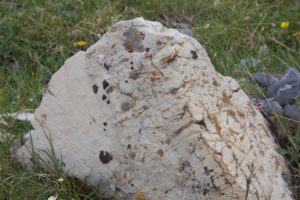
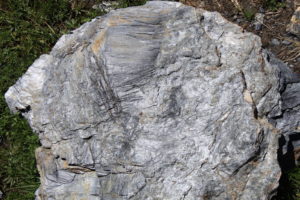
The colours, marks and texture is an aspect I try to reflect in the work, see below.
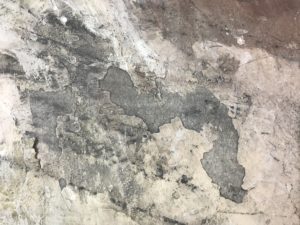
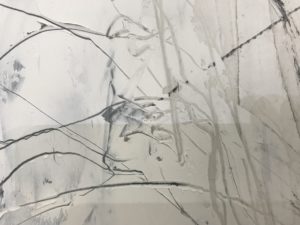
Four details of two works, VoP5 and VoP10 (2017)
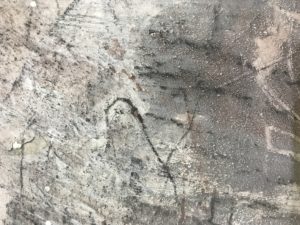
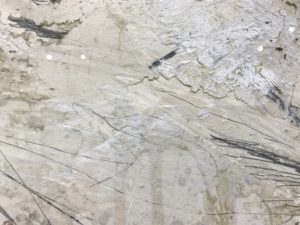
The physicality of painting back in the studio echoes the physical movement through the landscape and my Employed Localised Haptic Memory. Remembering the feelings and emotions as your feet find their way, a level path or surface to follow, for instance, at times knocked or slip as you walk over thin shale of rocks and stones. As you paint, the knife or brush either glides or stutters over the unlaying surface. The palette knife is like the ice axe or crampon, carving and scraping the edge of the glaciated paint, scraping the landscape a visceral relationship ensues and echoes between both the hand and making and the hands and feet of walking.
In the book ‘Touching the Rock’ by John Hull, a University Lecturer in 1983 who during mid-career became blind and which lead him to write his book says, “If the blind live in time, the deaf live in space. The deaf measuring time by seeing movement if however the deaf gaze out on a world in which there is no movement such as the stars, the deserted street, or some mountain scenery, then there is a quality of permanence static consistency. In losing the kind of awareness of space, blind people have less awareness of and changeability. The world of the Blind is more ephemeral since sounds come and go.”(HULL: 93)
- Tilley, C., (2008) "Phenomenological approaches to landscape archaeology" from David, B. and Thomas, J., Handbook of landscape archaeology pp.271-276, Walnut Creek, California: Left Coast Press.
- Hull, J. 2009, Touching the Rock SPCK Publishing

